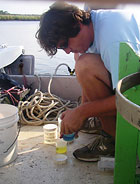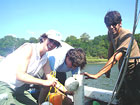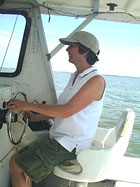

 | |||||||||||||||||
|
|
Journals 2006/2007Anna Hilton
July 6, 2006 I joined Angela Salisbury, a wildlife biologist who works for the Department of Natural Resources (DNR) and her research team for the second day of the Village Creek sampling research project. Other crew members were Patrick Biondo, a natural resource technician who works for DNR, and Jordan Felbar, a graduate student working at the College of Charleston in environmental studies. The DNR team had taken water samples from three reaches at the mouth of Village Creek and had left another sonde the day before. Angela called the sonde a "logger." The sonde logs the salinity, pH, turbidity, and chlorophyll levels in the creek. The mouth of Village Creek is near Bear Island in eastern Colleton County, South Carolina. An investigator for the National Centers for Coastal Ocean Science (NCCOS) asked Angela to bring back samples of oysters from two different reaches for an oyster restoration research project. I am very interested in this project because the South Carolina Aquarium and the York Town educational programs involve elementary students in oyster restoration in our area.
The sampling at the mouth of Village Creek has to be done from a research boat. Angela left the boat at the Michael D. McKenzie Field Station on Bear Island after the first day of sampling. Angela told me a swarm of mosquitoes had attacked them at the field station the day before, and the team was not looking forward to a repeat attack. Pat and Jordan bravely volunteered to get out of the truck to hook it up to the boat while Angela and I backed the truck up to the trailer and boat. Angela did this very quickly with all the windows of the truck rolled up. We drove to a nearby boat ramp swatting a few mosquitoes that followed Pat and Jordan back into the truck. Morgan River reminded me of the times I had spent in Beaufort fishing with my father. I was delighted to see fiddler crabs scurrying away on the banks of the creek as we passed by in the boat. Pelicans and seagulls flew overheard while egrets and herons explored the oyster beds for a seafood breakfast. Our DNR research boat was equipped with a benthic grab and an otter trawl. The boat had a GPS unit that helped Angela navigate Morgan River to the reaches in Village Creek. Both Guy and Angela took samples of the fauna in the creek today. Guy pulled a seine net in the salt marsh creek and Angela trawled for her samples of fish and marine invertebrate. They both carefully followed the procedures of the Tidal Creeks Monitoring and Assessment Project. I thought about my science students and how carefully they design the procedures of their school science projects to control all variables in their investigations.
After the last trawl at the last reach Angela use the GPS to motor back to the reach to get the "logger." Everyone searched the horizon for the orange and white buoys that marked the position of the sonde. Angela let me take over the wheel when we spotted the buoys. We had a twenty minute wait before the data-collecting sonde could be retrieved. Everyone pulled out water bottles and bag lunches while we waited. Six dolphins noisily sprayed and flipped near us as they looked for their own lunch in the tidal creek.
Angela and Pat checked out the condition of the boat trailer back at the boat landing while Jordan secured the sonde and the cooler containing the trawl samples. Jordan quickly fell asleep on the ride back to Fort Johnson. Angela and Pat talked about processing the samples back at the lab that afternoon and the upcoming sampling trip to Sapelo Island. Lightning, thunder, and a downpour followed us into Charleston. Pat knew this would delay the storm water research Jordan had planned for the next day. The scientists and students were very interested in each others projects and shared much more than equipment and data. I really enjoyed the enthusiasm of the scientists and students I met on the two-day sampling trip to Village Creek.
|
||||||||||||||||




